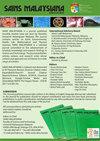Volatile Compounds Detected by SPME-GC-MS in Fish Viscera Extracts with Attractant Activity Against House Fly Musca Domestica from Chemometric FTIR Fingerprints
IF 0.8
4区 综合性期刊
Q3 MULTIDISCIPLINARY SCIENCES
引用次数: 0
Abstract
Fish viscera has been locally applied as fly attractant in North Moluccas. The objective of this study was to evaluate the efficacy of attractant from fish viscera extracts and to determine the indispensable active extracts with chemometric FTIR fingerprints, as well as to characterize volatile compounds of the extracts. Attractant activity against house fly Musca domesctica and FTIR spectra were analyzed for the ethanol, acetone and hexane extracts of stomach, intestines, liver, and combination of the viscera from skipjack tuna stored for 1-2 days at room temperature. SPME-GC-MS analysis was applied for active extracts to determine volatile compounds. OPLS analysis result showed that FTIR spectra were correlated with the attractant activity (R2 0.974 and Q2 0.89), and compounds with functional groups S-H, N-H, O-H, and C-O have the strong correlation. Ethanol and acetone extracts of mixed viscera from 2 days storage are the active extracts. The volatile compounds in the extract through the SPME-GC-MS analysis belong to ketone, amine, phenol, heterocyclic, aromatic aldehyde, fatty acid, fatty acid ester and sulfur compounds are reported.从化学计量傅立叶变换红外指纹图谱出发,用 SPME-GC-MS 检测对家蝇具有引诱活性的鱼内脏提取物中的挥发性化合物
北摩鹿加群岛当地一直将鱼内脏用作苍蝇引诱剂。本研究的目的是评估鱼内脏萃取物的引诱剂功效,通过化学计量学傅立叶变换红外光谱指纹图谱确定不可或缺的活性萃取物,并描述萃取物挥发性化合物的特征。分析了在室温下储存 1-2 天的鲣鱼内脏乙醇、丙酮和正己烷提取物对家蝇 Musca domesctica 的引诱活性和傅立叶变换红外光谱。对活性提取物进行了 SPME-GC-MS 分析,以确定挥发性化合物。OPLS 分析结果表明,傅立叶变换红外光谱与引诱剂活性相关(R2 0.974 和 Q2 0.89),官能团为 S-H、N-H、O-H 和 C-O 的化合物具有很强的相关性。贮藏 2 天的混合内脏的乙醇和丙酮提取物是活性提取物。通过 SPME-GC-MS 分析,报告了提取物中的挥发性化合物属于酮、胺、酚、杂环、芳香醛、脂肪酸、脂肪酸酯和硫化合物。
本文章由计算机程序翻译,如有差异,请以英文原文为准。
求助全文
约1分钟内获得全文
求助全文
来源期刊

Sains Malaysiana
MULTIDISCIPLINARY SCIENCES-
CiteScore
1.60
自引率
12.50%
发文量
196
审稿时长
3-6 weeks
期刊介绍:
Sains Malaysiana is a refereed journal committed to the advancement of scholarly knowledge and research findings of the several branches of science and technology. It contains articles on Earth Sciences, Health Sciences, Life Sciences, Mathematical Sciences and Physical Sciences. The journal publishes articles, reviews, and research notes whose content and approach are of interest to a wide range of scholars. Sains Malaysiana is published by the UKM Press an its autonomous Editorial Board are drawn from the Faculty of Science and Technology, Universiti Kebangsaan Malaysia. In addition, distinguished scholars from local and foreign universities are appointed to serve as advisory board members and referees.
 求助内容:
求助内容: 应助结果提醒方式:
应助结果提醒方式:


